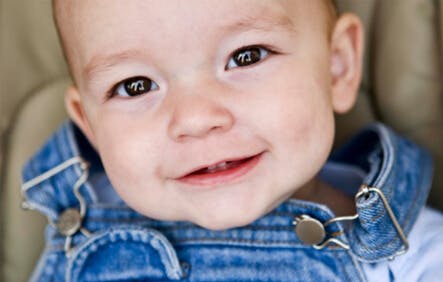Breast Buds

Question
I have read that newborns (boys and girls) may secrete drops of milk from their nipples as a result of the hormones in their mother's breast milk. My 3 week old baby girl has not produced drops of milk, but there are small lumps of tissue under her nipples that are fairly firm, almost like tiny developing breasts. Is this normal? How long do you expect that it might last?
Amy Obrist - Los Angeles, California
Dr. Greene's Answer
Several times throughout childhood, Amy, there are situations where the past and future collide. No, not collide really. It’s more like a double-exposed photograph with the past, present, and future superimposed. I can remember seeing my children toddle across the family room wearing my loafers, many sizes too big. Conjured up in my mind is an image of myself as a toddler, tromping about in my dad’s shoes. While watching these scenes, one in my family room, one in my mind, I recognize that someday my children will really fill those shoes — perhaps with children of their own.
For me, breast buds in an infant is another one of those precious times. A burst of your hormones passed to your daughter shortly before delivery is one of the finishing touches in preparing her lungs to breathe air when she is born. These hormones include estrogen and androgens and can have several transient side effects. Real, mature breast tissue forms, creating firm lumps under the nipples. Some babies even leak some real milk from their breasts. This is colorfully named witch’s milk, a term which captures the magic of the situation, but inappropriately attributes sinister and supernatural overtones to this natural wonder. Breast buds commonly occur in both boys and girls.
These firm lumps of breast tissue are normal and not a cause for concern unless they are accompanied by fever, pain, redness, warmth, or other signs of inflammation. If any of these symptoms occur, you’ll want to contact your pediatrician to rule out a breast infection.
Many little girls may also develop a cloudy vaginal discharge. Some little girls will even have mini-periods — with blood appearing at the vagina during the first week as estrogen levels fall rapidly. Some boys and girls will have genitalia swollen by the hormones. Many boys and girls will have their first experience of acne, with real pimples appearing on the face and upper chest at around three weeks and lasting for three or four weeks. In the majority of cases, no treatment is needed and the acne will go away on its own. Creams and other over-the-counter medications may actually exacerbate it, so it’s best to just leave it alone. I recommend simply a gentle wipe down with warm water once or twice a day – no cleansers or soap are needed at this young age.
All of these changes disappear gradually, usually over the first several months of life, as your hormones and their effects vanish. Typically, the breast buds are the first to form and the last to go.
Budding breasts, a face full of pimples, and her first period are all visible reminders of a moment not long ago when she was still inside your uterus. They might even remind you that not terribly long ago, you were inside your own mother and receiving these same hormones. And these same little bumps are a glimpse of a future that seems so far away right now (especially on those sleepless nights), but will come all too soon — when your teenage daughter becomes a woman.
Cherish moments like this when they occur. It might be when she stands in front of a mirror putting on makeup, or delights to play with a briefcase, or it might be her graduation from kindergarten. Notice those junctures where, for a fleeting moment, she looks grown-up — and appreciate the brief double-exposure of the future and the past.
Resources and References
Karaayvaz S. Clinical Evaluation of Breast in Childhood. Eur J Breast Health. 2019;15(3):137-140.


